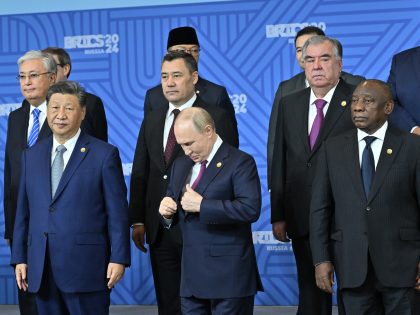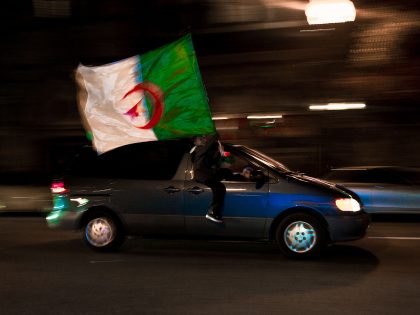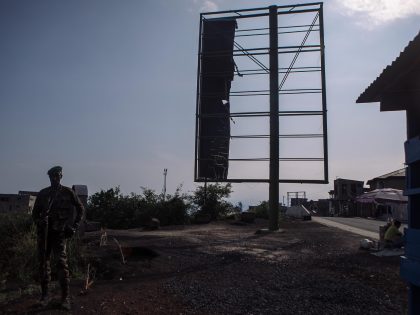The struggle for moral authority in Zimbabwe
Zimbabwe's regime does not to surrender to anyone its guardianship of the post-independence narrative, symbols and authority.

One of the most remarkable protest acts in Zimbabwe in 2016 was a little-publicized act by a small group of female Christian worshippers who dressed up in sacks, and prayed and wailed for three days. It was indicative of a year replete with seemingly symbolic and performative acts of defiance against President Robert Mugabe and the ruling party ZANU-PF’s chokehold on power. Then in mid-2016, preacher Evan Mawarire started a campaign that startled the regime. Mawarire posted a video on Youtube of himself, swaddled in Zimbabwe’s national flag and lamenting the country’s state of affairs. Perhaps in spite of himself, he had gone straight to the heart of the beast. His words and actions appealed immediately to Zimbabweans’ moral sensibilities. Following Mawarire’s post, various other movements – mostly launched through social media – mustered courage and confronted the state using different tactics. Some organized saucepan-clanging marches, prayer meetings, dressed up in academic regalia and played street football or just sat, looking idle on the streets. The actions injured the ego of a regime that prides itself in ruling over one of Africa’s most educated populations; the message of “graduates,” in particular, was unequivocal: “We are graduates today, rovha mangwana ([and]loafers tomorrow).” These actions, while seemingly eschewing direct confrontation with a notoriously brutal state machinery, effectively challenged the moral authority of the regime. The last thing the Zimbabwe regime wants to surrender to anyone, even before the national airport, is its guardianship of the post-independence moral narratives and symbols and the authority that comes with them.
After independence from British colonial rule in 1980, Robert Mugabe moved swiftly to consolidate his hold on the political and historical landscape narratives and imaginations of the country. Monuments were built to commemorate fallen war combatants and civilians of the independence war. Besides Independence Day, other days were also set aside for commemoration of the war and its heroes. Particular care was taken in ensuring that the war narrative, national days and associated emblems, such as the national flag, were closely related to President Mugabe and the ruling party. It’s no exaggeration that Independence Day in Zimbabwe today is associated, not with a national embrace of a nation, and the journeys Zimbabweans have travelled together, but with the ruling party’s reaffirmation of its perceived one-sided heroism, moral hegemony and authority.
Mawarire prayerful lamentation and use of the national flag on Independence Day was a radical political action indeed: A flag sans the meanings attributed to it, we are reminded by social theorist Emile Durkheim, is just but a piece of cloth, but as a societal emblem, it is imbued with a moral force that galvanizes collective sentiments and exerts moral demands on individuals in society. His action hit the regime square in the face. The national outpouring and support that followed Mawarire’s Youtube post and his subsequent persecution, became for many not only a civic duty, but also a higher moral one. For the regime, it was an extreme challenge to its moral authority and the backlash was immediate. Mawarire had to skip the country into exile.
Prayer meetings, spontaneous possession by ancestral spirits in courtrooms during activists’ trials and other quasi-religious activities continued after he left. Such political actions do not lack historical precedence in Africa. In 1985, the anthropologist Jean Comaroff wrote about Apartheid South Africa – and how the use of brute force in suppressing political protests gave rise to symbolic and performative practices, often involving ritual practice, in place of “open discourse.” In her analysis, Black Africans’ religious communities took centre stage in defying the brutal Apartheid machinery. Similarly, in the Zimbabwean case where any kind of dissent is met with booted feet, gunfire, water cannons and tear gas canisters, creative modalities of political action, such as the manipulation of religious and cultural codes, are common responses from the oppressed. During the country’s liberation struggle against white minority rule in the 1970s, it was not uncommon for Black guerilla armies of ZANU and ZAPU to seek spiritual endorsement from traditional chiefs and spirit mediums. Over and above their Marxist “revolutionary” training, ZANU fighters often sought legitimacy from mediums of the spirit of Mbuya Nehanda, a female ancestor claimed by many Shona-speaking groups in the country. So, political efforts that lean on things religious and spiritual have today also become useful in shaking the edifice of dictatorship. In fact, they are more useful than the calculated ten-point, calibrated plans and “organic” political actions of those identifying as “secular” political outfits. It is pastoral figures, and other religio-political actors who have shown a knack at articulating the social experiences of Zimbabweans, and they have a redemptive appeal to the long-suffering nation.
What does this mean then for the future of political organizing and mobilization in Zimbabwe? Clearly, modalities of mainstream struggle also have to change or accommodate other creative political actions, even when they appear transient. It’s no longer helpful to cast aspersions on those who don’t bring forward political manifestos or chant revolutionary slogans. Religious, moral and psychic solidarities are not compensatory to “real” political action. They are real, and they reflect sentiments rooted in extant conditions of social existence. In Zimbabwe people have turned en masse in recent years towards religion – be it charismatic churches, traditional revivalist movements or other spiritual groups. Civil society movements, such as those of organized labor and students (the traditional constituencies of opposition parties) have been largely decimated during the last two decades. So, religion, taken here in the broader sense as a rallying point for the collective social organization and action, has gained more from the crisis. And it is religion that will have the most significant role in either delaying or inspiring future meaningful political action in Zimbabwe.



















